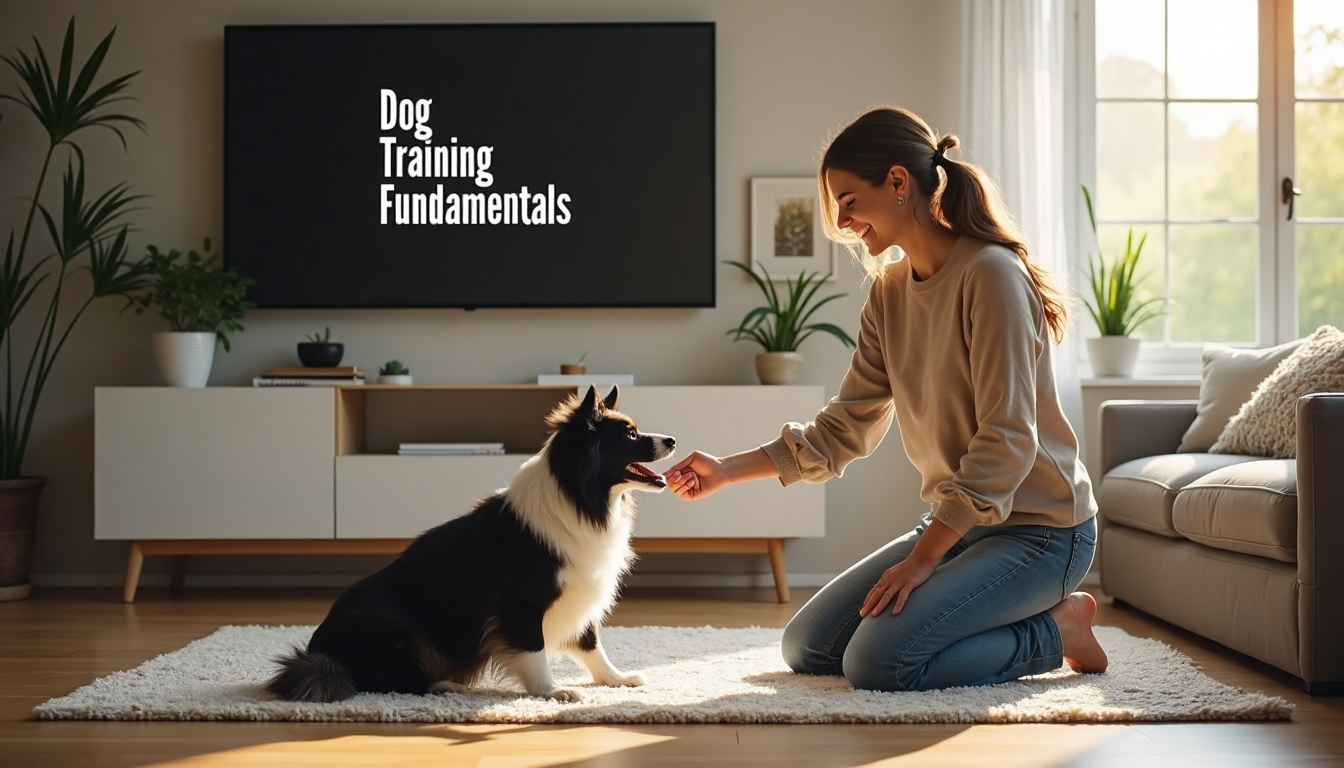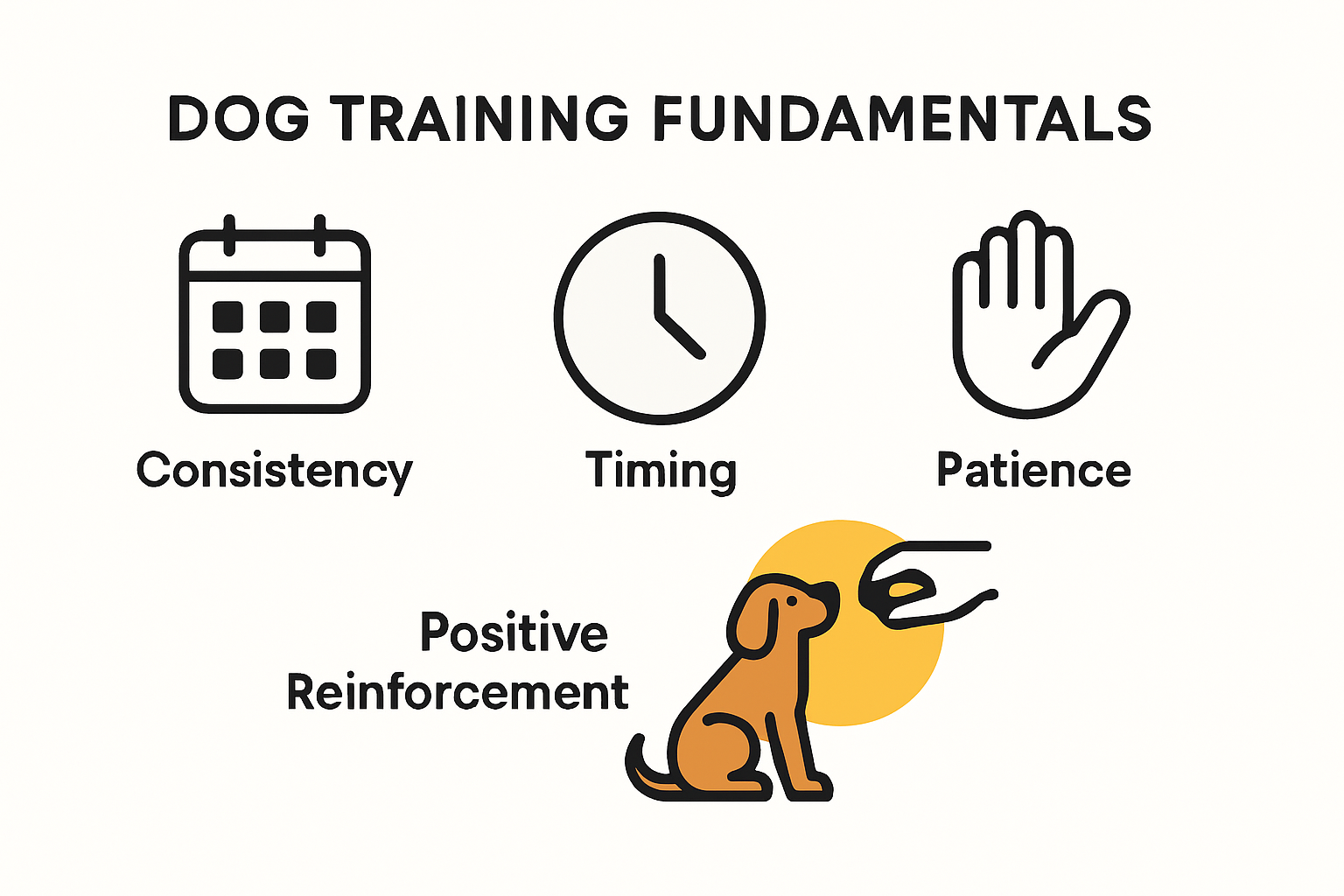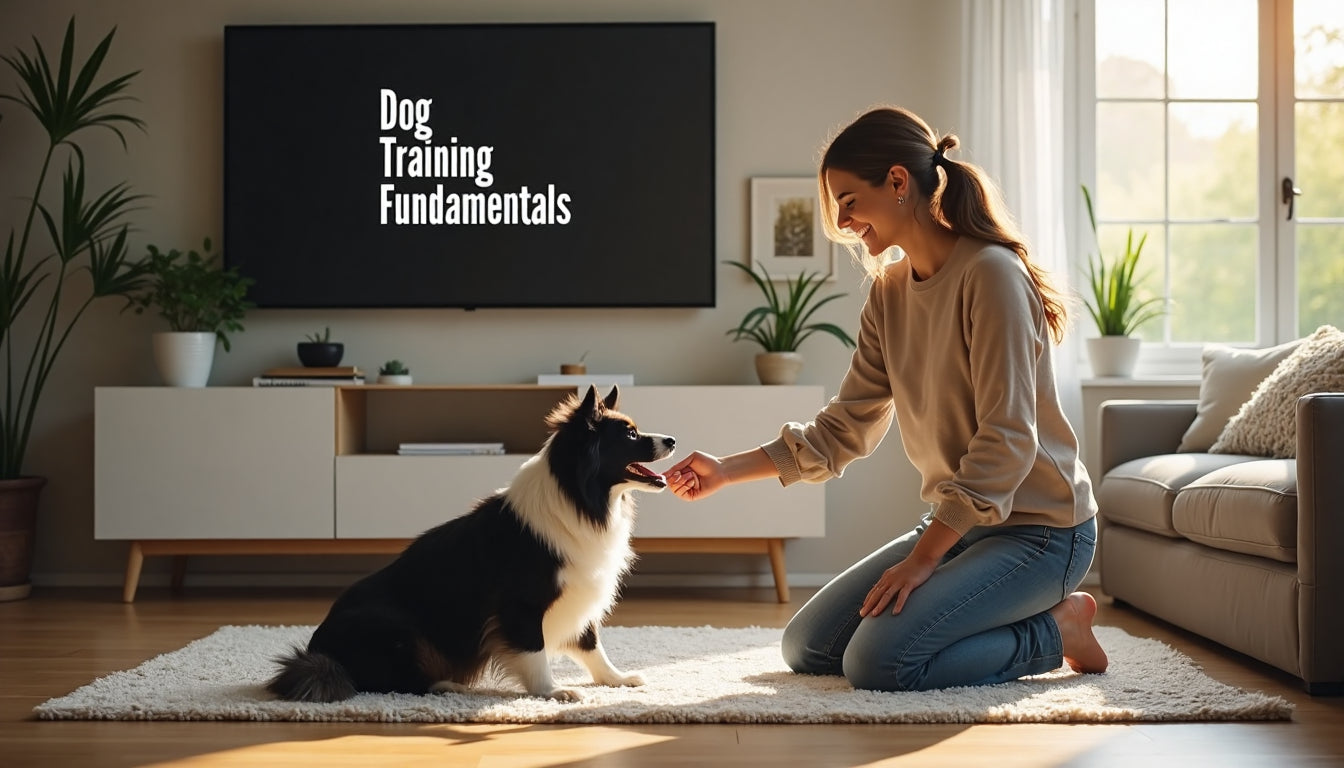
Dog owners often think basic obedience is enough to keep their pups happy and well-behaved. Yet here’s something that might surprise you. Over 99 percent of dogs exhibit at least one behavioral issue, with more than 85 percent struggling with separation or attachment problems. Forget the simple sit and stay routines. A truly successful handler masters communication, patience, and the art of adapting to every dog’s unique personality. Want to know what modern training really takes?
Table of Contents
- Understanding Dog Training Fundamentals
- Core Commands And Positive Reinforcement
- Addressing Common Dog Behavior Challenges
- Tailoring Training For Special Needs Dogs
Quick Summary
| Takeaway | Explanation |
|---|---|
| Consistency is Key | Successful dog training relies on consistent communication, including uniform signals and immediate rewards to reinforce desired behaviors. |
| Positive Reinforcement is Essential | Employing positive reinforcement creates a motivating training environment that emphasizes rewards and builds trust between the handler and dog. |
| Understanding Behavioral Triggers | Recognizing the underlying emotional states of dogs, such as fear and anxiety, is crucial in addressing behavioral challenges effectively. |
| Tailored Approaches for Special Needs Dogs | Working with special needs dogs requires specialized training techniques that focus on the individual animal’s strengths and capabilities. |
| Patience and Empathy | Training is a gradual process, and handlers should approach challenges with patience and a compassionate understanding of each dog’s unique needs. |
Understanding Dog Training Fundamentals
Dog training is a complex interaction between human and canine that requires understanding fundamental principles of communication, learning, and behavior. Successful training goes beyond simple commands and transforms into a sophisticated dialogue that builds trust, respect, and mutual understanding.

The Science of Canine Learning
Modern dog training fundamentals are rooted in scientific principles of animal behavior and learning theory. Research from animal behavior experts reveals that dogs learn through two primary mechanisms: Pavlovian conditioning and operant conditioning. Pavlovian conditioning involves creating associations between stimuli, where a neutral signal becomes linked with a meaningful event. Operant conditioning focuses on how behaviors are shaped by consequences.
Understanding these mechanisms allows handlers to develop more effective training strategies. Positive reinforcement emerges as the most powerful approach. According to a comprehensive study published in animal behavior research, dogs trained with reward-based methods demonstrate significantly lower stress levels and more optimistic learning attitudes compared to those subjected to aversive training techniques.
Communication and Relationship Building
Effective dog training transcends mechanical skill transmission. It is fundamentally about establishing clear communication channels and building a strong, trusting relationship. Dogs are social creatures that read human body language, tone, and emotional states with remarkable precision. Handlers must learn to communicate consistently and compassionately.
Early socialization plays a critical role in this process. Developmental research indicates that exposing dogs to diverse environments and stimuli during their critical developmental stages helps create well-adjusted animals capable of learning complex tasks and adapting to various situations.
Successful training requires patience, consistency, and an understanding that each dog is an individual with unique learning capabilities. Handlers must be prepared to adapt their approach based on the dog’s personality, breed characteristics, and previous experiences.
For those looking to dive deeper into structured training methods, our comprehensive guide on teaching basic commands provides step-by-step insights into establishing fundamental communication with your canine companion.
Key principles of dog training fundamentals include:
- Consistency: Maintaining uniform signals and responses
- Timing: Providing immediate feedback
- Patience: Understanding learning is a gradual process
- Positive Reinforcement: Rewarding desired behaviors
By embracing these scientific and compassionate approaches, handlers can transform training from a series of commands into a meaningful dialogue that strengthens the human-dog bond.
To help you review essential components of dog training at a glance, here’s a summary table highlighting key principles and their importance:
| Principle | Description |
|---|---|
| Consistency | Uniform signals and responses for clarity |
| Timing | Immediate feedback reinforces correct behaviors |
| Patience | Recognizing that learning is a gradual process |
| Positive Reinforcement | Rewards to encourage desired actions |
| Adaptation | Tailoring approach to suit dog’s personality and experiences |
Core Commands and Positive Reinforcement

Positive reinforcement represents the most humane and effective approach to dog training, transforming commands from mechanical instructions into meaningful communication between handler and canine. This method focuses on rewarding desired behaviors, creating a learning environment that motivates dogs to repeat actions that result in positive outcomes.
The Foundations of Positive Reinforcement
Research from animal behavior experts reveals that positive reinforcement is rooted in operant conditioning. This scientific approach demonstrates that behaviors followed by rewards are more likely to be repeated. When a dog receives immediate positive feedback such as treats, praise, or play, they associate the specific action with a pleasant experience, making them more inclined to perform that behavior again.
The Capital Humane Society outlines essential commands that form the cornerstone of effective dog training:
- Sit: A fundamental command that establishes basic control
- Stay: Critical for safety and impulse control
- Come: Essential for recall and preventing potential dangerous situations
- Down: Helps manage excitement and promotes calm behavior
- Heel: Enables controlled walking and prevents pulling
- Leave it: Protects dogs from potential hazards
The following table summarizes these core training commands and their main purpose, helping you understand their role in everyday training:
| Command | Purpose |
|---|---|
| Sit | Establishes basic control |
| Stay | Ensures safety and impulse control |
| Come | Provides reliable recall and prevents danger |
| Down | Manages excitement and encourages calm |
| Heel | Facilitates controlled walking, prevents pulling |
| Leave it | Protects from hazards and unwanted objects/things |
Implementing Effective Reward Strategies
Successful positive reinforcement requires precision and consistency. Timing is crucial dogs must receive their reward immediately after performing the desired behavior to create a clear connection. The reward should be something the dog finds genuinely motivating, which varies between individual animals. Some dogs respond best to food treats, while others prefer verbal praise, physical affection, or a favorite toy.
Handlers must also understand that variability in rewards prevents predictability and maintains the dog’s engagement. This means occasionally replacing food treats with other forms of positive reinforcement, keeping the training process dynamic and interesting.
Learn more about building unbreakable connections through training and discover how positive reinforcement can transform your relationship with your canine companion.
Important considerations for implementing positive reinforcement include:
- Consistency in command language
- Immediate reward delivery
- Gradual progression of difficulty
- Patience with individual learning rates
- Adapting techniques to the dog’s personality
By embracing positive reinforcement, handlers create a training environment that is not just about obedience, but about building trust, communication, and a deep mutual understanding. This approach recognizes dogs as intelligent, emotionally complex beings capable of learning through encouragement and respect.
Addressing Common Dog Behavior Challenges
Dog behavior challenges are complex interactions that require understanding, patience, and strategic intervention. Research from the American Society for the Prevention of Cruelty to Animals reveals that most behavioral issues stem from communication gaps between dogs and their handlers, highlighting the critical need for targeted, compassionate training approaches.
Understanding Behavioral Triggers
Behavioral challenges often emerge from underlying emotional states. According to Purdue University’s Canine Welfare Science program, fear and anxiety represent significant contributors to problematic behaviors. These emotional responses can manifest through various actions such as aggression, excessive barking, destructive chewing, and separation anxiety.
The prevalence of behavioral issues is striking. A comprehensive study published in the Journal of Veterinary Behavior found that over 99% of dogs exhibit behaviors that handlers might consider challenging, with specific patterns emerging:
- 55.6% display aggression-related behaviors
- 85.9% show separation and attachment issues
- 49.9% demonstrate fear and anxiety responses
Here’s a statistical snapshot of common behavioral challenges in dogs, providing a quick reference to their prevalence:
| Behavioral Issue | Prevalence (%) |
|---|---|
| Aggression-related behaviors | 55.6 |
| Separation/attachment issues | 85.9 |
| Fear and anxiety responses | 49.9 |
| At least one behavior challenge | >99 |
Strategic Intervention Techniques
Addressing behavioral challenges requires a multifaceted approach that combines understanding, patience, and consistent training. Handlers must first identify the root cause of the behavior, which might involve environmental factors, past experiences, or underlying health conditions.
Key strategies for managing behavioral challenges include:
- Positive Reinforcement: Redirecting negative behaviors by rewarding alternative, desired actions
- Consistent Boundaries: Establishing clear, predictable rules and expectations
- Environmental Modification: Reducing stress triggers and creating safe, comfortable spaces
- Professional Consultation: Seeking expert guidance for complex behavioral patterns
For a comprehensive guide on behavioral training strategies, our experts provide in-depth insights into understanding and transforming challenging canine behaviors.
Important considerations when addressing behavioral challenges include recognizing that each dog is an individual with unique emotional landscapes. What works for one dog may not be effective for another. Patience, consistency, and a willingness to adapt are crucial.
Handlers should approach behavioral challenges with empathy, understanding that these behaviors are often the dog’s way of communicating distress, fear, or unmet needs. By creating a supportive environment that prioritizes emotional well-being and clear communication, handlers can help their dogs develop more balanced and confident behaviors.
Ultimately, successful behavior modification is not about suppression but about understanding, communication, and building a stronger, more trusting relationship between handler and dog.
Tailoring Training for Special Needs Dogs
Training special needs dogs requires a nuanced, compassionate approach that recognizes each animal’s unique capabilities and challenges. Unlike traditional training methods, working with dogs experiencing physical disabilities, sensory impairments, or behavioral complexities demands extraordinary patience, creativity, and specialized understanding.
Understanding Individual Capabilities
Research from specialized canine disability organizations reveals that dogs with disabilities often possess heightened alternative sensory capabilities. Trainers can leverage these enhanced abilities by developing communication strategies that focus on the dog’s remaining strengths rather than perceived limitations.
Special needs dogs may present with various conditions requiring tailored training approaches:
- Mobility impairments
- Visual or hearing disabilities
- Neurological disorders
- Anxiety and trauma responses
- Developmental challenges
Adaptive Training Strategies
Successful training for special needs dogs involves multiple strategic considerations. A comprehensive study from Oregon State University demonstrated that adaptive training techniques can significantly improve learning outcomes by customizing interventions to individual dog capabilities.
Key adaptive training principles include:
- Sensory Compensation: Utilizing alternative communication methods
- Incremental Learning: Breaking complex tasks into manageable steps
- Positive Reinforcement: Emphasizing rewards and minimal stress environments
- Patience: Allowing extended learning timelines
Explore our comprehensive guide to service dog skill development for more in-depth strategies tailored to unique canine learning needs.
Handlers working with special needs dogs must develop an intimate understanding of their dog’s specific challenges and strengths. This requires ongoing observation, professional consultation, and a commitment to continuous learning and adaptation.
Important considerations include:
- Regular veterinary consultations
- Customized exercise and mental stimulation plans
- Consistent, gentle training approaches
- Emotional support and stress management
The ultimate goal of training special needs dogs transcends traditional obedience. It represents a profound journey of mutual understanding, trust-building, and celebrating each dog’s extraordinary potential. By approaching training with empathy, creativity, and scientific understanding, handlers can help these remarkable animals lead fulfilling, confident lives.
Every special needs dog represents a unique training opportunity. Success lies not in conforming to standard expectations, but in recognizing and nurturing each animal’s individual brilliance.
Frequently Asked Questions
What are the basic principles of dog training?
Successful dog training relies on consistency, positive reinforcement, understanding behavioral triggers, and patience with the individual dog. Providing immediate feedback and adapting to each dog’s unique personality are also essential.
How does positive reinforcement work in dog training?
Positive reinforcement involves rewarding desired behaviors with treats, praise, or other motivators, making it more likely for the dog to repeat those behaviors. This method builds trust and strengthens the bond between the handler and the dog.
What are common behavioral issues in dogs?
Common behavioral issues include aggression-related behaviors (55.6%), separation or attachment problems (85.9%), and fear or anxiety responses (49.9%). Addressing these challenges requires understanding and empathy from the handler.
How can I tailor training for a special needs dog?
Training for special needs dogs should focus on their individual capabilities. Use adaptive training strategies such as incremental learning, employing sensory compensation, and providing an understanding environment to foster their strengths and minimize stress.
Turn Training Fundamentals Into Real-World Success With iPupPee
Dog training takes more than simple commands. The article highlights that nearly every dog faces behavioral challenges like separation anxiety or difficulty communicating their needs. You want consistency, positive reinforcement, and a stronger bond, but real-life progress is often limited by communication gaps. Many handlers struggle to understand their dog’s signals, especially those caring for service animals, rescues, or dogs with special needs.

Experience the next level of connection and safety. The iPupPee device transforms everything you have learned about dog training into clear, daily two-way communication. Give your dog a reliable voice to signal needs, boost their confidence, and keep everyone safe at home or on the go. Learn how easy it is to start—explore our real customer stories and training resources now. Take the next step for your dog’s independence and peace of mind today. Visit ipuppee.com to see how you can change the way you and your dog connect.
Recommended
-
https://ipuppee.com/blogs/news/how-to-teach-dogs-basic-commands)
-
https://ipuppee.com/blogs/news/service-dog-obedience-training-guide-2025)
-
https://ipuppee.com/blogs/news/dog-behavioral-training-guide-2025)
-
https://ipuppee.com/blogs/news/service-dog-training-challenges-2025)
-
https://ipuppee.com/blogs/news/training-techniques-for-dogs-guide-owners-handlers-2025)

